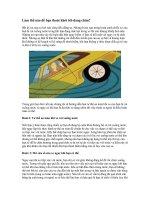Breaching the Fortress Wall -Understanding Terrorist Efforts to Overcome Defensive Technologies pdf
Bạn đang xem bản rút gọn của tài liệu. Xem và tải ngay bản đầy đủ của tài liệu tại đây (1.31 MB, 183 trang )
This document and trademark(s) contained herein are protected by law
as indicated in a notice appearing later in this work. This electronic
representation of RAND intellectual property is provided for non-
commercial use only. Permission is required from RAND to reproduce, or
reuse in another form, any of our research documents.
Limited Electronic Distribution Rights
Visit RAND at www.rand.org
Explore RAND Homeland Security
View document details
For More Information
This PDF document was made available
from www.rand.org as a public service of
the RAND Corporation.
6
Jump down to document
THE ARTS
CHILD POLICY
CIVIL JUSTICE
EDUCATION
ENERGY AND ENVIRONMENT
HEALTH AND HEALTH CARE
INTERNATIONAL AFFAIRS
NATIONAL SECURITY
POPULATION AND AGING
PUBLIC SAFETY
SCIENCE AND TECHNOLOGY
SUBSTANCE ABUSE
TERRORISM AND
HOMELAND SECURITY
TRANSPORTATION AND
INFRASTRUCTURE
WORKFORCE AND WORKPLACE
The RAND Corporation is a nonprofit
research organization providing
objective analysis and effective
solutions that address the challenges
facing the public and private sectors
around the world.
Purchase this document
Browse Books & Publications
Make a charitable contribution
Support RAND
This product is part of the RAND Corporation monograph series.
RAND monographs present major research findings that address the
challenges facing the public and private sectors. All RAND mono-
graphs undergo rigorous peer review to ensure high standards for
research quality and objectivity.
Prepared for the Department of Homeland Security
Breaching the
Fortress Wall
Understanding Terrorist Efforts to
Overcome Defensive Technologies
Brian A. Jackson • Peter Chalk • R. Kim Cragin
Bruce Newsome • John V. Parachini • William Rosenau
Erin M. Simpson • Melanie Sisson • Donald Temple
The RAND Corporation is a nonprofit research organization providing
objective analysis and effective solutions that address the challenges
facing the public and private sectors around the world. RAND’s
publications do not necessarily reflect the opinions of its research clients
and sponsors.
R
®
is a registered trademark.
© Copyright 2007 RAND Corporation
All rights reserved. No part of this book may be reproduced in any
form by any electronic or mechanical means (including photocopying,
recording, or information storage and retrieval) without permission in
writing from RAND.
Published 2007 by the RAND Corporation
1776 Main Street, P.O. Box 2138, Santa Monica, CA 90407-2138
1200 South Hayes Street, Arlington, VA 22202-5050
4570 Fifth Avenue, Suite 600, Pittsburgh, PA 15213-2665
RAND URL: />To order RAND documents or to obtain additional information, contact
Distribution Services: Telephone: (310) 451-7002;
Fax: (310) 451-6915; Email:
Library of Congress Cataloging-in-Publication Data
Breaching the fortress wall : understanding terrorist efforts to overcome defensive
technologies / Brian A. Jackson [et al.].
p. cm.
“MG-481.”
Includes bibliographical references.
ISBN 0-8330-3914-8 (pbk. : alk. paper)
1. War on Terrorism, 2001–—Technology. 2. Security systems. 3. Terrorism—
Prevention. 4. Terrorism—Prevention—Case studies. 5. Terrorism—Case studies.
6. National security. I. Jackson, Brian A. (Brian Anthony)
HV6431.B737 2007
363.325'72—dc22
2006001721
Cover design by Eileen Delson La Russo
Photo by TSgt Cedric H. Rudisill, U.S. Air Force
This research was sponsored by the United States Department of
Homeland Security and was conducted under the auspices of the
Homeland Security Program within RAND Infrastructure, Safety, and
Environment.
iii
Preface
Technical countermeasures are key components of national efforts to
combat terrorist violence. Efforts to collect data about and disrupt ter-
rorist activities through human intelligence and direct action, infor-
mation gathering, and protective technologies complement technical
countermeasures, helping to ensure that terrorists are identified, their
ability to plan and stage attacks is limited, and, if those attacks occur,
their impact is contained.
Given the potential effect of such measures on the terrorists’
capabilities, it is not surprising that they act to reduce or neutralize
the impact of defensive technologies on their activities. In the event
that the terrorists’ counterefforts are successful, the value and protec-
tion provided by defensive technologies can be substantially reduced.
rough case studies of terrorist struggles in a number of nations, this
document analyzes the nature and impact of such terrorist counteref-
forts on the value of defensive technologies deployed against them.
e information presented here should be of interest to home-
land security policymakers in that it identifies potential weaknesses in
defensive technology systems, thereby informing threat assessment and
providing a basis for improving the design of future defensive technolo-
gies. It extends the RAND Corporation’s ongoing research on terror-
ism and domestic security issues. Related RAND publications include
the following:
Brian A. Jackson, John C. Baker, Peter Chalk, Kim Cragin, John
V. Parachini, and Horacio R. Trujillo, Aptitude for Destruction,
•
iv Breaching the Fortress Wall
Vol. 1: Organizational Learning in Terrorist Groups and Its Impli-
cations for Combating Terrorism, MG-331-NIJ, 2005.
Brian A. Jackson, John C. Baker, Peter Chalk, Kim Cragin, John
V. Parachini, and Horacio R. Trujillo, Aptitude for Destruction,
Vol. 2: Case Studies of Organizational Learning in Five Terrorist
Groups, MG-332-NIJ, 2005.
Kim Cragin and Sara A. Daly, e Dynamic Terrorist reat: An
Assessment of Group Motivations and Capabilities in a Changing
World, MR-1782-AF, 2004.
Peter Chalk and William Rosenau, Confronting “the Enemy
Within”: Security Intelligence, the Police, and Counterterrorism in
Four Democracies, MG-100-RC, 2004.
is monograph is one in a series of studies examining techno-
logical issues in terrorism and efforts to combat it. is series focuses
on understanding how terrorist groups make technology choices and
respond to the technologies deployed against them. is research was
sponsored by the U.S. Department of Homeland Security, Science and
Technology Directorate, Office of Comparative Studies.
The RAND Homeland Security Program
is research was conducted under the auspices of the Homeland
Security Program within RAND Infrastructure, Safety, and Environ-
ment (ISE). e mission of RAND Infrastructure, Safety, and Envi-
ronment is to improve the development, operation, use, and protec-
tion of society’s essential physical assets and natural resources and to
enhance the related social assets of safety and security of individuals
in transit and in their workplaces and communities. Homeland Secu-
rity Program research supports the Department of Homeland Security
and other agencies charged with preventing and mitigating the effects
of terrorist activity within U.S. borders. Projects address critical infra-
structure protection, emergency management, terrorism risk man-
agement, border control, first responders and preparedness, domestic
threat assessments, domestic intelligence, and workforce and training.
•
•
•
Preface v
Questions or comments about this monograph should be sent
to the project leader, Brian A. Jackson ().
Information about the Homeland Security Program is available online
( Inquiries about homeland security
research projects should be sent to the following address:
Michael Wermuth, Director
Homeland Security Program, ISE
RAND Corporation
1200 South Hayes Street
Arlington, VA 22202-5050
703-413-1100, x5414
Contents
vii
Preface iii
Figures
xi
Tables
xiii
Summary
xv
Acknowledgments
xxv
Abbreviations
xxvii
CHAPTER ONE
Introduction 1
Defensive Technologies and the Effort to Combat Terrorism
3
Terrorist Efforts to Overcome Defensive Technologies
7
About the Study
8
About is Monograph
11
CHAPTER TWO
Palestinian Terrorist Groups 13
Introduction
13
Information Acquisition and Management
22
Preventive Action
26
Denial
29
Response
34
Conclusion
34
CHAPTER THREE
Jemaah Islamiyah and Affiliated Groups 39
Introduction
39
Information Acquisition and Management
42
Preventive Action
48
Denial
52
Investigation
54
Conclusion
55
CHAPTER FOUR
Liberation Tigers of Tamil Eelam 59
Introduction
59
Information Acquisition and Management
69
Denial
76
Conclusion
79
CHAPTER FIVE
Provisional Irish Republican Army 83
Introduction
83
Information Acquisition and Management
85
Preventive Action
96
Denial
99
Response
103
Investigation
105
Conclusion
109
CHAPTER SIX
Conclusions:
Understanding Terrorists’ Countertechnology Efforts
115
Terrorist Strategies for Countering Defensive Technologies
116
Transferability of Terrorist Countertechnology Strategies
121
Implications of Terrorist Countertechnology Activities for
Homeland Security Efforts
125
In Conclusion: e Role of Technology in Combating Terrorism
132
viii Breaching the Fortress Wall
APPENDIX
Prominent Acts of LTTE Suicide Terrorism, 1987–2002 135
Bibliography
139
Contents ix
Figures
xi
1.1. e Terrorist Activity Chain 2
1.2. Defensive Technologies Across the Terrorist Activity Chain
5
2.1. Terrorist Attacks in Israel, the West Bank, and Gaza Strip
During the Oslo Period, 1993–1999
15
2.2. Terrorist Attacks During the al-Aqsa Intifada, 2000–2005
16
2.3. Distribution of Terrorist Attacks Since September 2000
18
2.4. Route Map of Israeli Security Barrier
31
6.1. Terrorist Countertechnology Strategies
119
Tables
xiii
2.1. Palestinian Groups’ Technological Innovations:
Purpose and Intended Mitigation of Government
Countermeasures
35
3.1. Jemaah Islamiyah Technological Innovations:
Purpose and Intended Mitigation of Government
Countermeasures
55
4.1. Estimates of the Efficiency and Effectiveness Matrix of
Search Modalities According to Sri Lankan Intelligence
Sources
71
4.2. Liberation Tigers of Tamil Eelam Technological
Innovations: Purpose and Intended Mitigation of
Government Countermeasures
80
5.1. Provisional Irish Republican Army Technological
Innovations: Purpose and Intended Mitigation of
Government Countermeasures
109
A.1. Prominent Acts of LTTE Suicide Terrorism, 1987–2002
135
xv
Summary
e level of threat posed by a terrorist group
1
is determined in large
part by its ability to build its organizational capabilities and bring
those capabilities to bear in violent action. As part of homeland secu-
rity efforts, technology systems play a key role within a larger, inte-
grated strategy to target groups’ efforts to do so and protect the public
from the threat of terrorist violence. Although many types of technol-
ogy have roles to play in the overall effort to fight terrorism, this analy-
sis focuses on a class of tools that we call defensive technologies—the
systems and approaches deployed to protect an area and its citizens
from terrorism by discovering and frustrating the plans of terrorists
operating therein. e technologies that we have defined as defensive
technologies can be organized into five primary classes based on their
intended impact on the terrorist adversary:
Information acquisition and management. ese tools include
surveillance technologies and practices that enable law enforce-
1
Although some of the substate groups discussed in this book use tactics that are not purely
terroristic in nature—for example, mixing traditional military operations against opposing
security forces with terrorist bombings or assassinations—we use the terms terrorism and ter-
rorist violence as generic descriptors of the violent activities of substate groups.
In this book, we adopt the convention that terrorism is a tactic—the systematic and pre-
meditated use, or threatened use, of violence by nonstate groups to further political or social
objectives to coerce an audience larger than those directly affected. With terrorism defined
as a tactic, it follows that individual organizations are not inherently terrorist. We use the
terms terrorist group and terrorist organization as shorthand for “group that has chosen to use
terrorism.”
•
xvi Breaching the Fortress Wall
ment and security organizations to gather information on terror-
ist individuals, vehicles, and behaviors; to monitor sites and areas
(including border information systems aimed at excluding terror-
ists from the country); to detect concealed weapons and operations
in progress; and to maintain the profiles, databases, and systems
needed to manage and use such information once collected.
Preventive action. Technologies in this category include systems
to counter specific terrorist weapon systems (e.g., radio-detonator
jamming, antimissile systems) and systems designed to pre-
vent terrorist access to money, weapons, technologies, and other
resources or knowledge.
Denial. Such approaches include traditional hardening of poten-
tial targets (e.g., setbacks, blast walls, reinforced windows, or other
structures); design changes in potential targets to make them less
susceptible to attack (e.g., increasing the robustness of infrastruc-
ture systems, immune buildings); hardening of the population
(e.g., psychological preparedness efforts, vaccination); and secu-
rity or guard force deployment.
Response.
ese technologies are designed to provide multi-
ple capabilities, including defeating operations in progress (e.g.,
explosive ordnance disposal teams); ensuring that emergency
responses are adequate to treat casualties and limit the spread of
damage from attacks in progress; coordinating response opera-
tions for increased effectiveness; making antidotes or other treat-
ment methods for specific types of terrorist attacks readily avail-
able; and providing risk communication capabilities, which can
be used to shape public responses to minimize the effects of an
attack.
Investigation. Technologies in this domain include forensic sci-
ence and other investigative and identification technologies to
analyze terrorist weapons, track and apprehend suspects, support
prosecution of individuals responsible for terrorist operations,
or enable other sovereign action against individuals or terrorist
organizations.
•
•
•
•
Summary xvii
ese do not represent the only technologies relevant to efforts to
combat terrorism. A range of technologies applied in more proactive or
offensive operations against terrorist groups—including military weap-
onry and similar technologies—are not included within the scope of
this book. It should also be noted that the distinction between offensive
and defensive technologies is admittedly ambiguous; the same intelli-
gence-gathering system deployed in a defensive mode to detect terror-
ist operations in progress could clearly gather information supporting
offensive operations against terrorist organizations.
Although the contributions that technology can make in combat-
ing terrorism can be considerable, it should be noted that technology
is only one of many tools for combating terrorism. For example, virtu-
ally all sources consulted for this book emphasized the preeminence
of direct human intelligence—through infiltration of terrorist orga-
nizations or the recruitment of their members as agents—as the most
important element of an effort to combat terrorists’ activities.
2
e
emphasis of this book on technical systems should not be interpreted
as contradicting this view—rather, the work described here should be
seen as part of a multifaceted effort against terrorism to ensure that
technology complements other efforts as effectively and efficiently as
possible.
Terrorist Efforts to Overcome Defensive Measures
Although the variety of defensive technologies available enables broad-
based targeting of terrorists’ activities, defending a nation against ter-
rorism is not a one-sided game. Given the potential for defensive tech-
nologies to constrain the capabilities of terrorist groups and limit their
operational freedom, these organizations are acutely aware of govern-
ment efforts to deploy them and actively seek ways to evade or counter-
act them. is measure-countermeasure, move-countermove dynamic
is inherent in contests between organizations and, to the extent that
2
Personal interviews with former law enforcement officials, England (May 2005) and with
local officials, Indonesia, the Philippines, Singapore, and ailand (March–April 2005).
xviii Breaching the Fortress Wall
the terrorists’ efforts are successful, can significantly reduce or elimi-
nate the value of defensive technologies.
3
is book focuses on understanding terrorists’ countertechnology
efforts by drawing on relevant data from the history of a variety of ter-
rorist conflicts and applying that information to the broader techno-
logical questions relevant to current homeland security efforts. ese
cases were selected for examination:
Palestinian terrorist groups. In Israel, a variety of Palestinian
terrorist groups (including Hamas, Palestinian Islamic Jihad [PIJ],
and the al-Aqsa Martyrs Brigade) face a strong challenge from
Israeli defensive measures, including surveillance assets and the
barrier wall being constructed to prevent entry into Israel from
the West Bank and Gaza. ese groups have adopted a number
of responses, including avoidance and camouflage, a variety of
approaches to avoid the defensive wall, and new weapons that
maintain their offensive capabilities.
Jemaah Islamiyah (JI) and affiliated groups. In Southeast Asia,
JI and its affiliated groups face varied defensive measures across
the multiple countries in which they operate. ese groups have
adopted deception and forgery to maintain their ability to move
from country to country and operational and technical ways to
evade weapon detection technologies, and they have made other
changes in target selection and operations to preserve their capa-
bilities and operational freedom.
Liberation Tigers of Tamil Eelam (LTTE).
In Sri Lanka, LTTE
used suicide terrorism for high-priority offensive missions. A
number of defensive measures were put in place, including opera-
tive profiling, detection methods, and hardening potential targets
of attack. LTTE responded by modifying its operational prac-
tices to include out-of-profile operatives, evading detection tech-
3
Although examining this was beyond the scope of this study, it should also be noted that the
nature of the defensive technologies available and their application also shapes the “defender’s
perspective” about appropriate responses to the terrorist threat and assumptions about terrorist
behavior.
•
•
•
Summary xix
niques or hiding the signatures they were designed to detect, and
improving its techniques for penetrating defenses.
Provisional Irish Republican Army (PIRA).
In the United
Kingdom, PIRA faced a diversity of defensive technologies aimed
at undermining all facets of its operations. rough innovation
and various operational approaches, PIRA developed strategies to
counter security force information gathering and measures to jam
or neutralize the group’s weapons, protections around key targets,
and even the ability of police to investigate and gather evidence
after attacks.
Although the terrorist groups developed a wide variety of counter-
technology measures for specific defensive technologies, many specific
countermeasures they adopted have common elements that permit us
to define a smaller number of fundamental countertechnology strat-
egies. e groups applied these strategies, singly or in combination,
when faced with a defensive technology threat. ey are as follows:
Altering operational practices. By changing the ways in which
it carries out its activities or designs its operations, a terrorist
group may blunt or eliminate the value of a defensive technology.
Such changes frequently include efforts to hide from or otherwise
undermine the technology’s effect.
Making technological changes or substitutions. By modify-
ing its own technologies (e.g., weapons, communications, surveil-
lance), acquiring new ones, or substituting new technologies for
those currently in use, a terrorist group may gain the capacity to
limit the impact of a technology on its activities.
Avoiding the defensive technology. Rather than modifying
how it acts to blunt the value of a defensive technology, a terrorist
group may simply move its operations to an entirely different area
to avoid it. Such displacement changes the distribution of terror-
ism, and, although this may constitute successful protection in
the area in which the defensive technology is deployed, the ability
to shift operations elsewhere limits the influence that the technol-
ogy can have on the overall terrorist threat level.
•
•
•
•
xx Breaching the Fortress Wall
Attacking the defensive technology. If appropriate avenues are
available, a terrorist group may seek to destroy or damage a defen-
sive technology to remove it as a threat.
Although specific terrorist countertechnology efforts occasionally
may fall into more than one of these classes, this taxonomy of strategies
provides a systematic way to consider how terrorist organizations might
respond to a newly deployed defensive measure.
Addressing Terrorist Countertechnology Efforts in
Homeland Security Planning and Decisionmaking
e potential for terrorist groups to develop and deploy countermea-
sures for new defensive technologies must be addressed to ensure that
protective efforts are effective and resources are allocated wisely.
Lessons for the Design of Defensive Technologies
To ensure that new defensive technology systems provide the great-
est potential security benefits, they must be designed with terrorist
countertechnology behaviors and past successes in mind. e efforts of
the groups studied here suggest four techniques or approaches to use in
developing plans for new defensive technologies.
Red teaming technology systems. Given terrorist counter-
technology behaviors, there is a clear need to test or “red team”
new technologies, drawing on the terrorists’ available palette of
counterstrategies, to assess the limits of a technology before it is
built and deployed.
Assessing adversary information requirements. ere is a clear
need to analyze the information an adversary would need to cir-
cumvent the defensive technology and assess how the adversary
might gain access to that information.
Designing flexibility into defensive technologies. For most
defensive measures, terrorist groups will eventually develop coun-
terstrategies that limit their value. As a result, systems that are
•
•
•
•
Summary xxi
flexible—that are not locked into specific modes of operation and
can adapt themselves—may provide an added value.
Anticipating how technologies will guide terrorist adapta-
tion. When challenged by a new defensive technology, a suc-
cessful terrorist effort to adapt may actually build it into a more
potent threat than existed before the technology was deployed. To
limit the potential for such unintended consequences, the design
process for defensive systems should explore the effect of terrorist
countertechnology responses not only on the value of the defen-
sive systems, but also on the group overall and the nature of the
threat it poses.
Lessons for Planning the Technological Components of Homeland
Security Efforts
When terrorists are successful in countering all or part of the function-
ing of a defensive technology, the utility of the system may be signifi-
cantly reduced or lost entirely. Such losses devalue the costs
4
society
pays to design, produce, field, use, and maintain the technology.
5
As a
result, potential countertechnology efforts need to be included in plan-
ning in three critical areas:
Include terrorist countertechnology efforts in programmatic
and cost-benefit analyses of defensive systems. In assessing a
novel technology and its cost, the risk that its development and
deployment might fail to deliver promised benefits is an estab-
lished component of management planning. Like the competitive
risk that another firm will develop a superior product, render-
ing a company’s investments meaningless when both reach the
4
e concept of costs includes not only financial and materiel costs but also auxiliary costs
such as any reductions in privacy and civil liberties or costs paid in time or inconvenience by
the public as a result of implementation of the security measures.
5
For a nation as large and populous as the United States, these costs can be considerable.
For example, at the time of this writing, major initiatives regarding border security and criti-
cal infrastructure protection are under consideration. Given the scope of both problems and
the resources needed to implement solutions, considering how terrorists might act to counter
protective measures that are put in place is clearly critical.
•
•
xxii Breaching the Fortress Wall
market, successful terrorist countertechnology efforts can simi-
larly destroy the competitive advantage of a new defensive system.
is countertechnology risk must be assessed and included as part
of program management above and beyond the technological and
other risks inherent in the effort itself.
Consider the relative costs of countering a technology and
the cost of the technology itself. e cost that a defensive tech-
nology can impose on a terrorist group—in effort and resources
required to either withstand or counter its effects—is one measure
of its value. If the cost is great enough, the technology’s effect
can be decisive. e cost that the nation should be willing to pay
for a technology system must be related to its potential effect on
its adversaries. When a technology can be countered with little
investment on the part of the terrorist, the balance is in the terror-
ists’ favor. is is particularly problematic when a group can access
countertechnology strategies from other sources—for example,
through technology transfer from other terrorist groups—that
could significantly reduce or eliminate costs to the group.
6
Address multistep countertechnology activities in assem-
bling security technology portfolios. Although this discus-
sion focuses predominantly on single-step interactions between
terrorist groups and defensive technologies—a single response by
a group to a deployed technology—real conflicts are multistep
contests. In consecutive iterations of measure and countermea-
sure competition, the potential exists for the terrorist to eventu-
ally overwhelm even the most adaptable defensive technology and
reduce it to uselessness. If and when that occurs, new options will
be needed. Given the potential for such “adaptive destruction” of
individual security approaches, planning must consider defensive
technologies as a portfolio, maintaining possibilities for alterna-
tive approaches in the event that currently effective technologies
are neutralized.
6
A companion publication produced during this research project, Sharing the Dragon’s Teeth:
Terrorist Groups and the Exchange of New Technologies, by Kim Cragin, Peter Chalk, Sara A.
Daly, and Brian A. Jackson, addresses this topic in detail.
•
•
Summary xxiii
Conclusions
Although technologies can provide an edge in the effort to combat ter-
rorism, that edge can be dulled by terrorist countertechnology efforts.
An understanding of past terrorist efforts to counter defensive technol-
ogies underscores the complexity of designing new systems to protect
society from the threat of these violent organizations. is analysis sug-
gests that, in designing protective measures, it should not immediately
be assumed that the newest and most advanced technologies—the high-
est wall, the most sensitive surveillance—will best protect society from
terrorist attack. Drawing on common metaphors for defensive efforts,
a fortress—relying on formidable but static defensive measures—is a
limiting strategy. Once a wall is breached, the nation is open to attack.
Depending on the adaptive capabilities of the adversary, a defensive
model built of a variety of security measures that can be adjusted and
redeployed as their vulnerable points are discovered provides a supe-
rior approach to addressing this portion of terrorist behavior. However,
whatever combination of models and measures is chosen, it is only
through fully exploring an adversary’s countertechnology behaviors
that vulnerabilities in a nation’s defenses can be discovered and the best
choices made to protect the nation from the threat of terrorism.









